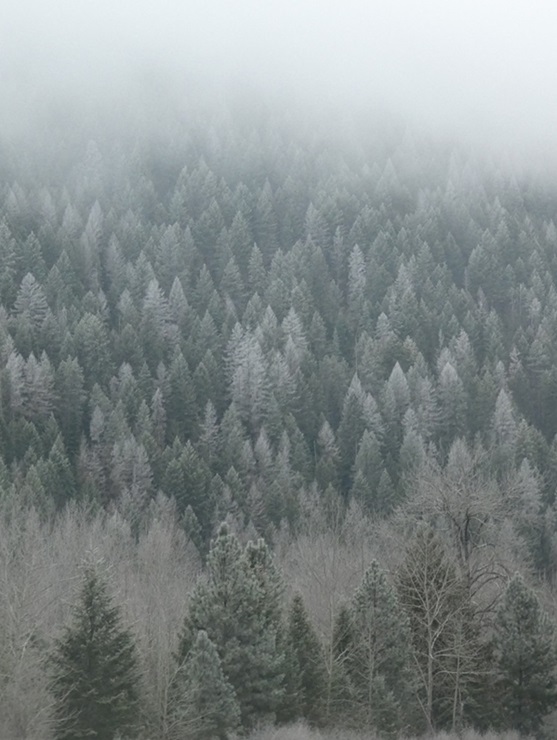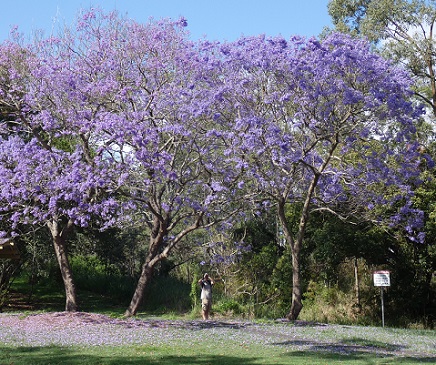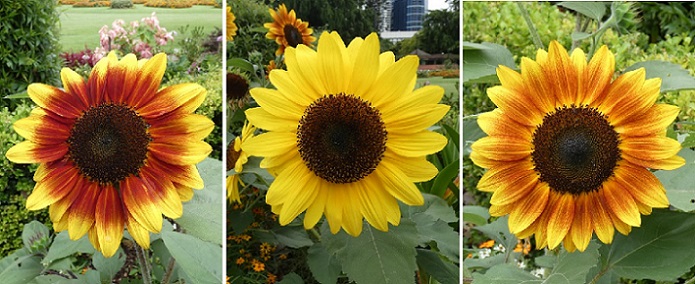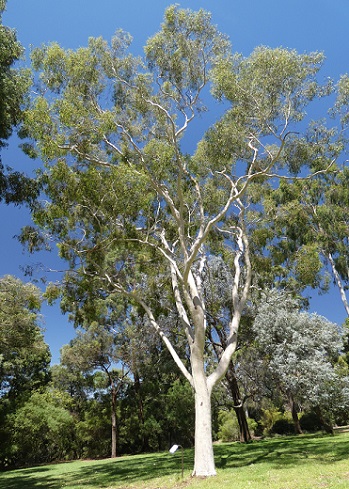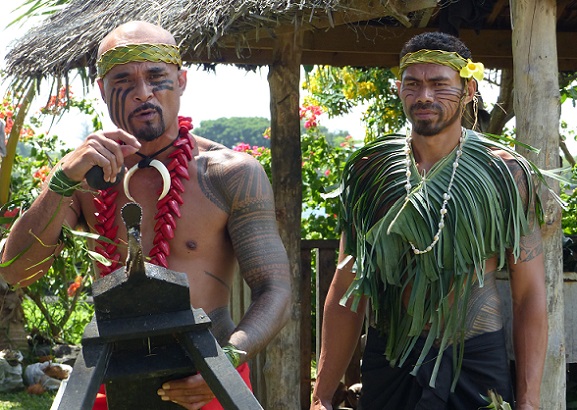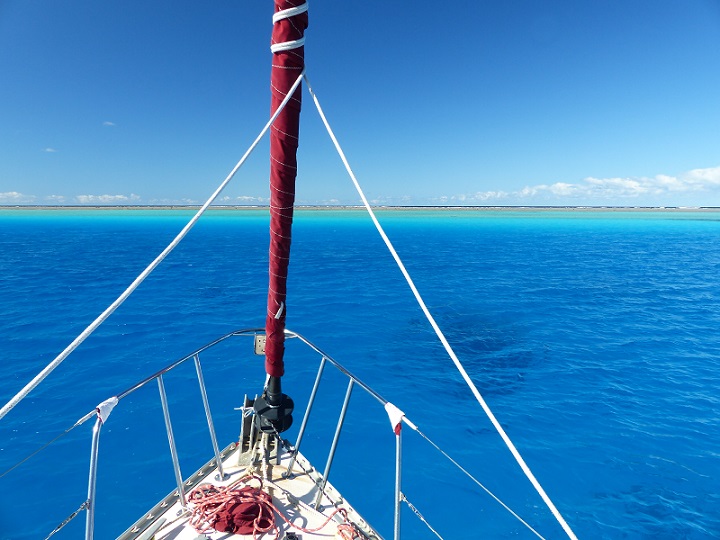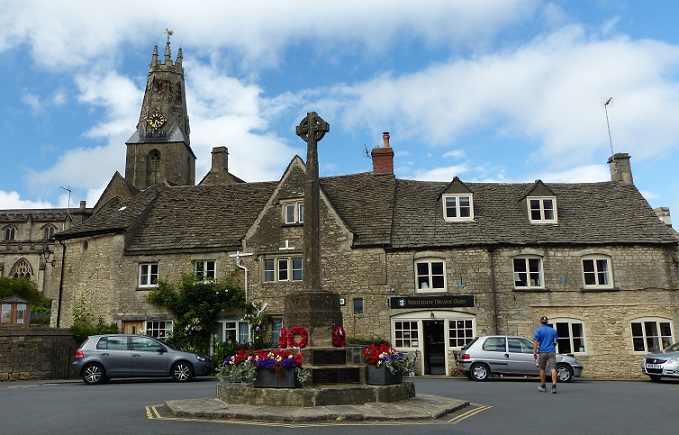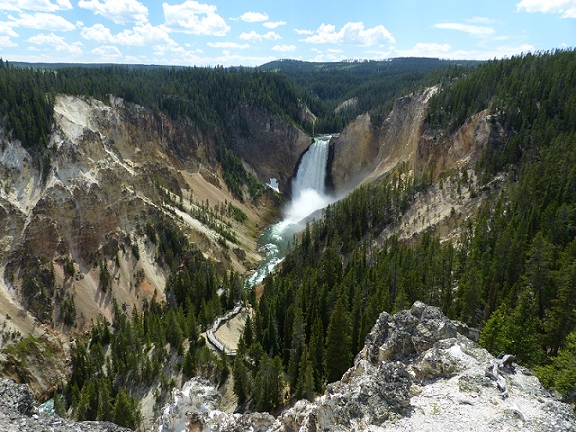
Tregoning
12 April 2024 | We are back aboard Tregoning in Mersin Marina, Mersin, Türkiye
02 April 2024 | We are in Toronto Airport, Canada: Tregoning is in Mersin Marina, Mersin, Türkiye
25 February 2024 | We are back in Gainesville, FL: Tregoning is in Mersin Marina, Mersin, Türkiye
18 February 2024 | We are in Glenwood, New Mexico: Tregoning is in Mersin Marina, Mersin, Türkiye
12 February 2024 | We are in Morro Bay, California: Tregoning is in Mersin Marina, Mersin, Türkiye
19 January 2024 | We are in Vancouver, BC Canada: Tregoning is in Mersin Marina, Mersin, Türkiye
01 January 2024 | We are in Washington State: Tregoning is in Mersin Marina, Mersin, Türkiye
15 December 2023 | We are in Minnesota: Tregoning is in Mersin Marina, Mersin, Türkiye
18 November 2023 | We are in Florida: Tregoning is in Mersin Marina, Mersin, Türkiye
29 October 2023 | We're in Florida - Tregoning is at B-dock, Mersin Marina, Mersin, Türkiye
21 October 2023 | 7 Oda Kapadokya Cave Hotel, Ürgüp, Türkiye
14 October 2023 | Hotel Aşikoğlu, Boğazkale, Türkiye
07 October 2023 | B-dock, Mersin Marina, Mersin, Türkiye
19 September 2023 | “Chez Jon & Angela”, Near Otterton, Devon, UK
14 September 2023 | Airbnb in Fortuneswell on the Isle of Portland, Dorset, UK
11 September 2023 | With Mike, Grange-over-Sands, Cumbria, UK
03 September 2023 | Ardington House, Ardington, Oxfordshire, UK
24 August 2023 | Near "Chez Joan and Peter", College of Roseisle, Moray, Scotland
11 August 2023 | Andrew's house (not exactly), Lichfield, UK
22 July 2023 | Chez Gail, near the New York Café, Budapest, Hungary
Full waterfalls, deep sinkholes, and giant clams
13 October 2017 | Apia Marina, ´Upolu Island, Samoa
Photo: The main sinkhole at To Sua Ocean Trench

On driving out of Apia, perhaps the most noticeable characteristic of Samoan villages is how magnificently they are decorated with brightly colored tropical plants. Even long sections of road between villages have been planted and are carefully maintained with other sections that have neatly mown grass verges. The Samoan climate certainly helps because there is plenty of rainfall to keep plants moist and many of the species used can be propagated from cuttings very easily. This floral splendor is so widespread in Samoa because there is an annual village beautification competition that is judged (we think) at Christmas. We are not sure what the prizes are, other than bragging-rights, but to keep the enthusiasm going, we gather that villages can also be fined for not maintaining a good roadside appearance.

School children and beautiful planting around Savaia Village
The lushness of the planted vegetation and of the forests of Samoa are in contrast to much of Tonga where conditions are considerably cooler and generally drier, especially in the winter. Compared to Tonga, there were also many fewer pigs and dogs wandering loose around the villages in Samoa but there were still but plenty of chickens. Oddly, we had seen virtually no aggressive dogs in Tonga (sweeping an arm back as if ready to throw something at them usually backed the dogs off quite nicely) but a few dogs ran out from driveways in Samoa and looked quite vicious although none made contact.
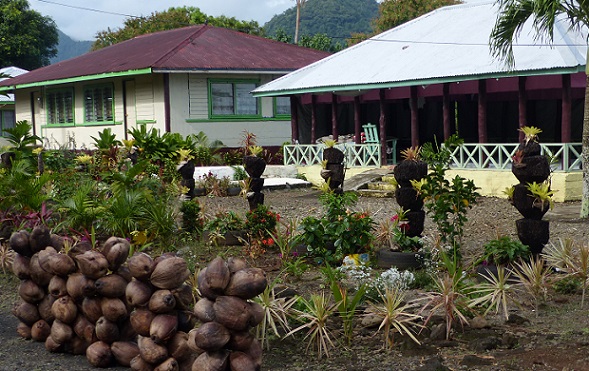
Neatly stacked coconuts and various ornamental plantings around houses in Falefa Village
Rainfall is quite consistent throughout the year in Samoa with about 12 inches or 300 mm of rain per month and this is responsible not only for the lushness of the vegetation but also for the abundance of waterfalls throughout the islands. Viewing areas for most of the accessible waterfalls are on private property and a small fee is paid to visit the sites, but usually some sort of improvements, gardens, or demonstration of traditional skills is included in this entrance fee.
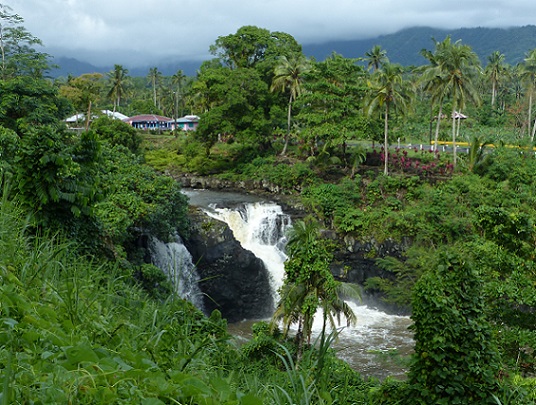
Falefa waterfall
After driving through several neat villages along the north coast of ´Upolu Island, east of Apia, we turned south to cross the island's central ridge, catching a distant view of Falefa waterfall. Climbing to Le Mafa Pass, the road goes through areas of cattle-pasture while the view back to the northern coast overlooks a broad, flat-bottomed valley full of coconut palms.

Part of the mid-island ridges near Le Mafa Pass
South of Le Mafa Pass, we turned off the road to park under a large breadfruit tree by a brightly painted house. After paying 10 tala each (US$4) to the young mother in the house, we walked along an attractive but muddy-in-places path to the edge of a tall cliff from which we had an impressive view of the Fuipisia Waterfall which must have been about 50 m (165 feet) tall. We followed a narrow, very muddy trail to the top of the falls over which I peered while Randall kept walking upstream. The recent rain meant that the falls had plenty of water but it was pretty muddy. Despite this, Randall had a quick dip to cool-down in one of the pools that was a respectable distance away from the falls.
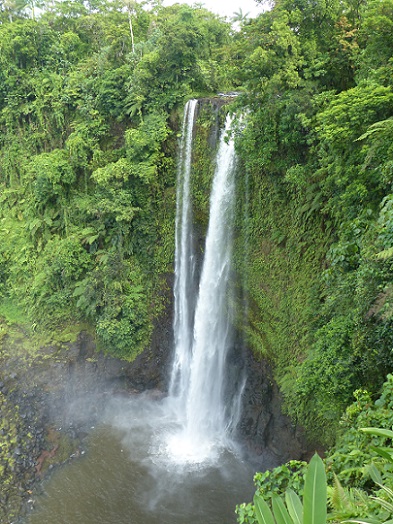
Fuipisia waterfall
Continuing south, we joined the coastal road at Lotofaga and headed east. We had lunch at the Aga Reef Resort where we were treated like royalty, principally because we were the only guests there. Apparently a few rooms were occupied at night but it was a little strange to see the place almost deserted. This southeast coast of ´Upolu was devastated by the 2009 tsunami and this resort had obviously been built since then. It was very attractive in a sophisticated, almost European style but even with waterside cabins, it somehow lacked much of a local or Polynesian feel.
Retracing part of our route westward, we spent the afternoon at To Sua Ocean Trench for 20 tala each. This name is a bit confusing because it sounds like a deep trench in the open sea but the site actually has two sinkholes (caves where the roofs have long-since collapsed) with seawater at the bottom. The largest of the sinkholes has a steep, 20-m long (66-feet) long wooden ladder down to a platform and ropes are strung in a X-shape across the water for people to hold onto if the swell or tidal movement of the water is strong.
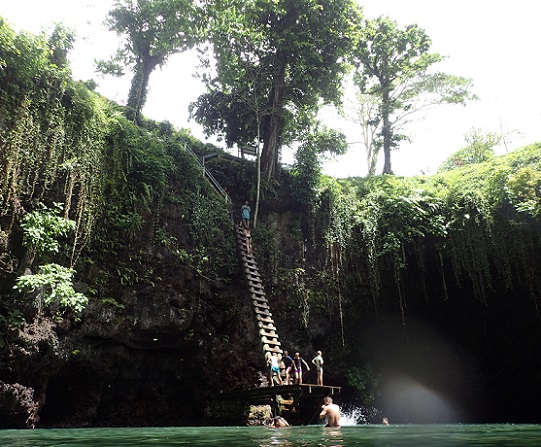
Looking up at the ladder in the main To Sua sinkhole
The seawater pool is a wonderful place in which to swim and for jumping into from the platform or, for the very bold, from the top of the ladder. The water is replenished from the sea at the bottom of this sinkhole but it is not possible to swim out to the sea (or, at least, not safely). It is possible to swim, or pull yourself along one of the ropes, under a dark, low cavern roof to a little beach at the bottom of the other sinkhole.
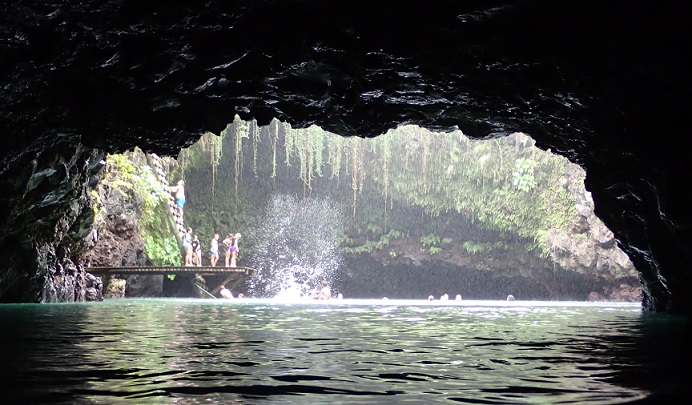
Looking from the bottom of the smaller sinkhole to the platform in the main sinkhole
The sinkholes now look so dramatic that we wondered if they had been regarded as a sacred site in the past. The nice lady at the entrance booth, however, explained that her family had owned the area for a long time but it was her father who gradually cleared away the wild vegetation. After he planted the current, extensive and attractive gardens, and built the robust wooden ladder down to the water, the sinkholes were no longer feared by the locals but became very popular.
The coastline just beyond the sinkholes is quite dramatic with jagged cliffs, sea-arches, and isolated black-rock pinnacles so in fine weather, it would be beautiful park at which to spend the whole day. This day had plenty of showers, so unless you wanted to stay huddled under one of the many fales much of the time, there was little incentive to linger once we had had our fill of splashing about in the sinkholes.
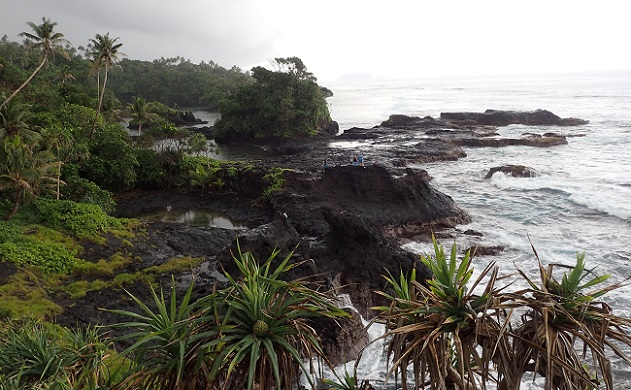
Part of the interesting coastline on the east side of To Sua Ocean Trench
We had booked to spend the night at Taufua Beach Fales on Lalomanu Beach, which is just west of Cape Tapaga at the southeast corner of ´Upolu Island. Their iconic yellow and green beach fales (some open with no solid walls and some enclosed) were fully booked so we were staying in an "ocean view" unit which we assumed was just across the street, looking out over the tops of the fales. However, after we had checked-in at the beachside reception office, we were told to follow a car that took us about 3 km (2 miles) through Lalomanu village on Cape Tapaga and then inland and uphill. We eventually arrived at one of several paired rooms behind a low embankment at the top of a sheer-sided ridge overlooking the coast that we estimated was, at least, 150-m (500-feet) high. This partly vegetated cliff, rising so steeply behind the long, white-sand beach, gives this coastline a particularly dramatic and Hawaiian-like appearance.
Yes, we were looking over the tops of the fales but they were mere specks on the distant shoreline far below us. The ocean-view description was something of an understatement as we could watch a procession of small dark clouds with showers march from east to west in front of us. We had an excellent view of the volcanic crater remains of Nuutele Island (which according to our map has the ruins of a leper colony) and, when the skies cleared, we could even see the west end of American Samoa's Tutuila Island, about 35 nm away. We guessed that it was the greatest distance that we have ever between our room and a hotel's reception.

Looking south, including Nuutele Island, from the embankment by our ocean-view room
We drove down to the fales for our evening meal which was served family-style and included an excellent selection of food. We were surrounded by two interesting couples, newlyweds from the US and a couple on vacation from Austria, who, at least appeared to be, obligingly fascinated about our tales of life on a boat. We were then all thoroughly entertained by a fiafia show (the reason why the fales were booked-up) which was performed by people from Lalomanu village. The performances were all accompanied by singing to an acoustic guitar and were introduced by a fa´afafine ("like a woman") who works at the fales. Like the fakaleiti in Tonga, fa´afafine are men who dress and behave like women and who are readily accepted as part of the Polynesian culture.
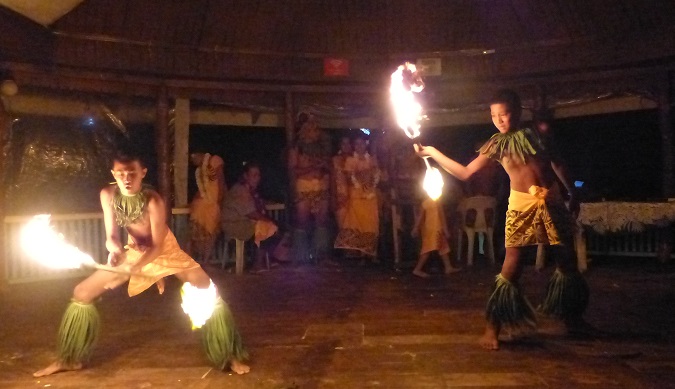
Young men play with fire at the fiafia show
The fiafia performances were very good and included several young men dancing with flaming batons. The show was free but during the final farewell song, sung in English, a good number of donations were made to support the village group. The main difference from the Siva Afi show in Apia, was a couple of songs that included audience participation. At first, women were called-upon to join in a hula-style of dance and, of course, our male partners were very keen to push us out on the stage.
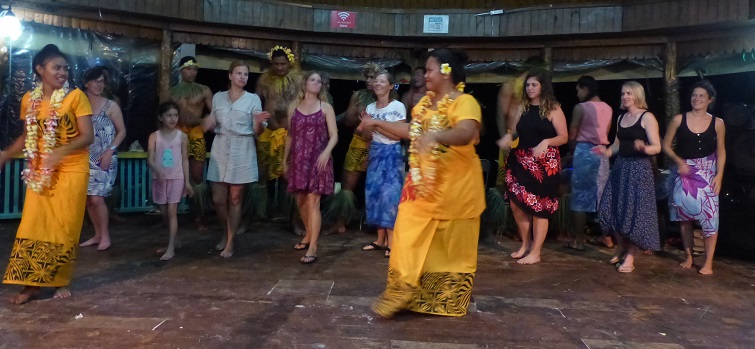
Palagi women try to follow the hula-style dance (Alison at the center in blue and white) Note: "Palagi" (white/western person) is in the Samoan spelling where "g" is pronounced "ng" so it sounds just like the Tongan, Palangi. Hence, Pago Pago in American Samoa is actually pronounced Pango Pango.
The men in the audience were generally accepting of the turn-about when the women's dance had finished and the men were called up to dance. They were mostly not quite so enthusiastic when the condition was made that their shirts had to be removed! Randall was a good sport about it, but he was a rather a beacon of whiteness in the tanned crowd and their dance included having to sit cross-legged and rapidly slap themselves all over their bodies.
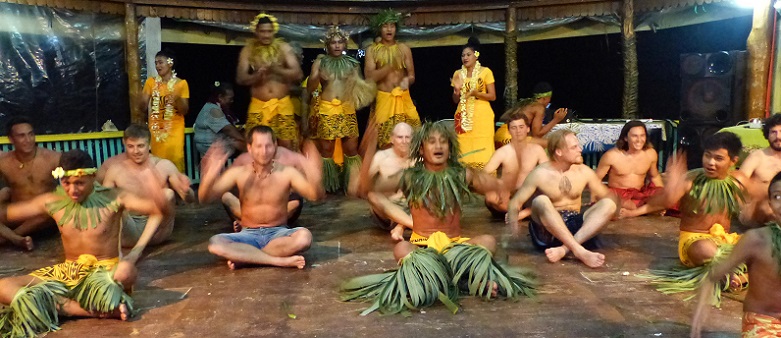
Randall seated behind the middle village performer during the rapid slap-dance. Notice that the villagers' arm positions are synchronized but the palagis' are not
At breakfast the following morning, we sat with a Kiwi woman, Faye, and her Samoan husband, Pafelio. They had lived for many years on Savai'i but were now on vacation with their children and grandchildren from their home in New Zealand. From them we learned more details about the 2009 tsunami. Faye is a nurse and, after the tsunami, she was part of a medical mission from New Zealand who stayed in southeastern ´Upolu to help treat the many people who had injuries resulting from the disaster.
At 6:48 am on 29th September 2009, only 8 minutes after an 8.1 magnitude earthquake occurred in the sea 103 nm south of Apia, a 10-m (33-feet) high wave came ashore along the south coast of ´Upolu Island. Waves of 4 to 6 m (13 to 23 feet) surged up to 1.6 km (1 mile) inland on Tutuila in American Samoa and because there was so little time for warnings, a total of 190 people were killed in the two nations and thousands were made homeless. Nine members of the family that own the Taufua Beach Fales were killed and all of the buildings along that narrow strip of coast were destroyed because of the damaging effects as the surge was rebounded and deflected at the base of the towering cliffs.
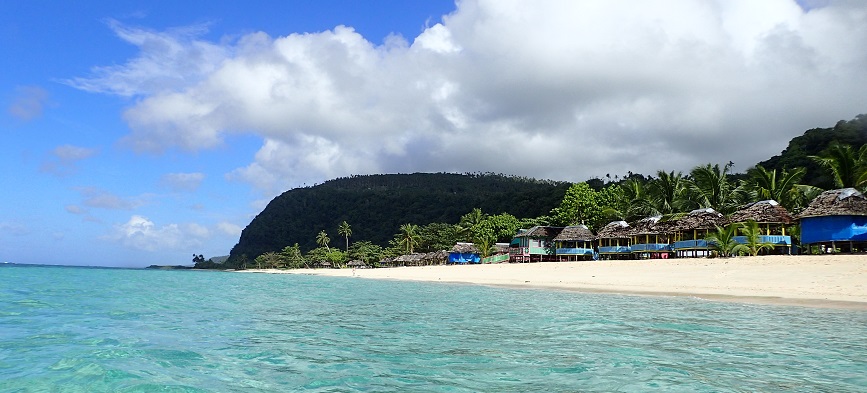
Taufua Beach Fales with the steep ridge on top of which we stayed beyond
The tsunami also caused major damage to the fringing-reef that lies just off Lalomanu Beach. When I snorkeled there after our breakfast at the fales, there were only small clumps of living coral scattered across the rubble of dead, broken coral. The reef might have been a little healthier at the outer edge but I did not dare to get too close because I had been warned that there were strong rip tides streaming out of a couple of narrow passes on either side of the Taufua Beach Fales.
Back in the car, we drove north through the string of villages along the eastern coast road. At Samusu, the road swings inland to the west and passes through scattered agricultural areas between steep-sided ridges. We passed a large lake on the north side of the road in the Uafato Conservation Area which, oddly, did not appear on any of our maps. Eventually, we rejoined the cross-island road that we had taken the day before, just south of Le Mafa Pass.
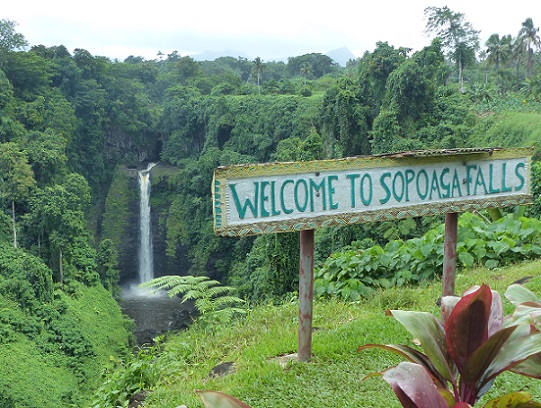
Returning towards the south coast, we stopped briefly between rain-showers, at the Sopo´aga Falls. Like the Fuipisia Falls a little further north, the 54-m (177-feet) high Sopo´aga waterfall descends in a single drop into an impressive, densely vegetated, steep-sided gorge. To help justify the 5 tala entrance fee to the viewing area, there was a neat kitchen-garden with some of the plants labelled. A local lady was sitting in a small fale hoping to show us how she could weave a basket from half of a palm frond. We asked if we could take her photograph but otherwise regretted that we had already watched this process at the Siva Fia evening and that we had to hurry along.
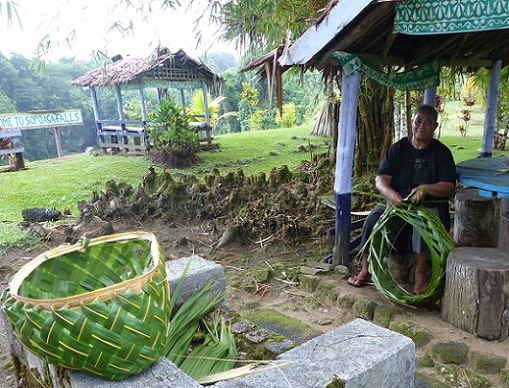
A woman weaving a basket from palm fronds at Sopo´aga Falls. These sustainable, compostable baskets are widely used for the transport and sale of fruit and vegetables.
The reason for our haste, was that we wanted to catch the high tide at our next destination, the village of Savaia, about 50 km (31 miles) west along the southern coast road. About 20 years ago, the villagers initiated a Marine Biodiversity Project with funding from various international sources including the UN. A large elliptical area inside the fringing reef has been marked with floats, within which no fishing is allowed. The preserve is mostly full of shallow coral (hence, the need to snorkel around high tide) and small fish.

Looking out towards the Savaia Conservation area (the floats are just beyond the light-colored sandy bottom)
The coral and fish alone are not wildly exciting but the villagers had developed a giant clam sanctuary with small calms enclosed in nursery areas under fine-mesh netting. Fist-sized clams were outside the netting nearby and these are surrounded by clams of increasing sizes up to about 1 m (3.3 feet) wide. These are by far the largest clams that we have ever seen and many of them had brightly colored, intricately patterned mantles. Needless to say, it was prudent to look and not touch the senior clams because if they shut quickly on a hand, it could be a nasty experience.
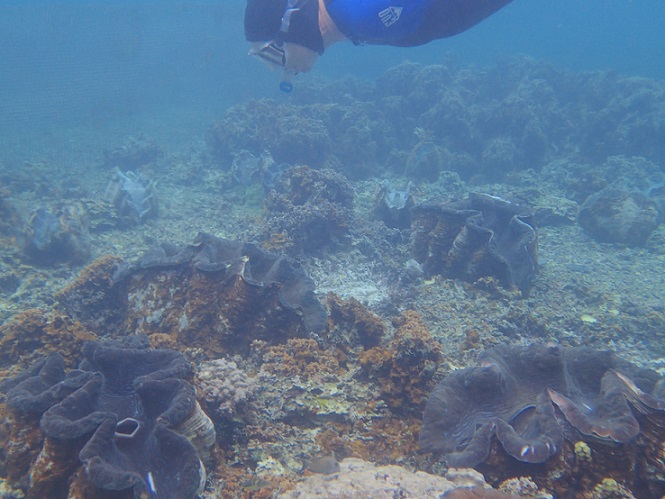
Randall peers into one of the giant clams at the Savaia Marina Biodiversity Project
After finding this first patch of clams rather randomly, we swam around the whole sanctuary expecting to see other groups of them but it appeared that the dozen or so full-sized clams that we had seen were the full extent of the adult population. This was a little disappointing from a conservation perspective but presumably there were just enough to keep visitors coming to the site. Arriving at the site in sunshine, there were four other carloads of snorkelers already there but with heavy rain sweeping across while we were in the water, no other cars showed-up.
The clam sanctuary was not mentioned in our Lonely Plant Guide to the South Pacific but we had heard about it from several taxi drivers and at the Tourist Information Center in Apia. The project brings some income to the village in the form of 20 tala per person entrance fees and some funding for improvements. An EU grant had supported the building of a toilet and shower block for snorkelers to use but with the light fixtures removed, only cold water, the showerhead missing, and nowhere to hang or place dry clothes or a towel, it was in pretty ragged shape. The woman collecting the entrance fee was friendly but her English was not quite sufficient for a detailed explanation of the conservation program and there were no interpretive signs about the clams, their life-cycle, and the project. We felt that there was a missed opportunity for more education and to expand the area of clams.
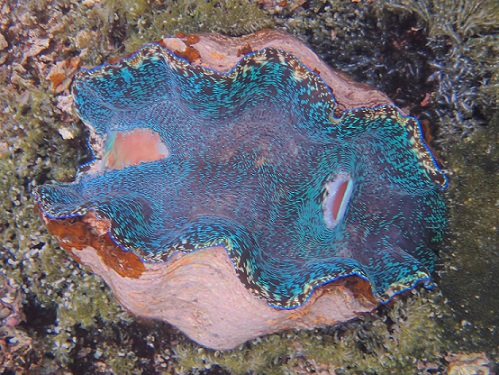
Looking down on the blue mantle with siphon holes of an open, 1-m wide, pink-shelled giant clam
To finish our tour of 'Upolu, we tried to continue along the coast road around the island's west end as our maps showed was possible. However, reality did not quite match the maps and rather than follow a rough, unsealed road that headed unexpectedly uphill, we turned around and after returning to Savaia, we took the cross-island road to the north coast. We drove west past the Faleolo International Airport and the terminal for the ferries to Savai´i Island to reach Cape Fatusofia at ´Upolu's western point. This area had a quite different appearance from the rest of the island with a wide, low, sandy coastline and a board expanse of shallow lagoon out to Manono Island. For some reason it reminded us of the Florida Keys.
Randall had read online that there is an historical marker at Cape Fatuosofia that explains where Samoan chief Malietoa Sevea had finally repelled from Samoa the Tongan warriors who had initially invaded Savai´i around 950 AD. This would have been our only historical stop for the two-day tour because there are surprisingly few such sites indicated on our maps of Samoa or in our guide book. When it transpired that the historical marker was within a resort complex, however, we decided that our two-day, whistle-stop tour of 'Upolu Island had been satisfying enough, and we turned our car back towards Apia.

School children and beautiful planting around Savaia Village
The lushness of the planted vegetation and of the forests of Samoa are in contrast to much of Tonga where conditions are considerably cooler and generally drier, especially in the winter. Compared to Tonga, there were also many fewer pigs and dogs wandering loose around the villages in Samoa but there were still but plenty of chickens. Oddly, we had seen virtually no aggressive dogs in Tonga (sweeping an arm back as if ready to throw something at them usually backed the dogs off quite nicely) but a few dogs ran out from driveways in Samoa and looked quite vicious although none made contact.

Neatly stacked coconuts and various ornamental plantings around houses in Falefa Village
Rainfall is quite consistent throughout the year in Samoa with about 12 inches or 300 mm of rain per month and this is responsible not only for the lushness of the vegetation but also for the abundance of waterfalls throughout the islands. Viewing areas for most of the accessible waterfalls are on private property and a small fee is paid to visit the sites, but usually some sort of improvements, gardens, or demonstration of traditional skills is included in this entrance fee.

Falefa waterfall
After driving through several neat villages along the north coast of ´Upolu Island, east of Apia, we turned south to cross the island's central ridge, catching a distant view of Falefa waterfall. Climbing to Le Mafa Pass, the road goes through areas of cattle-pasture while the view back to the northern coast overlooks a broad, flat-bottomed valley full of coconut palms.

Part of the mid-island ridges near Le Mafa Pass
South of Le Mafa Pass, we turned off the road to park under a large breadfruit tree by a brightly painted house. After paying 10 tala each (US$4) to the young mother in the house, we walked along an attractive but muddy-in-places path to the edge of a tall cliff from which we had an impressive view of the Fuipisia Waterfall which must have been about 50 m (165 feet) tall. We followed a narrow, very muddy trail to the top of the falls over which I peered while Randall kept walking upstream. The recent rain meant that the falls had plenty of water but it was pretty muddy. Despite this, Randall had a quick dip to cool-down in one of the pools that was a respectable distance away from the falls.

Fuipisia waterfall
Continuing south, we joined the coastal road at Lotofaga and headed east. We had lunch at the Aga Reef Resort where we were treated like royalty, principally because we were the only guests there. Apparently a few rooms were occupied at night but it was a little strange to see the place almost deserted. This southeast coast of ´Upolu was devastated by the 2009 tsunami and this resort had obviously been built since then. It was very attractive in a sophisticated, almost European style but even with waterside cabins, it somehow lacked much of a local or Polynesian feel.
Retracing part of our route westward, we spent the afternoon at To Sua Ocean Trench for 20 tala each. This name is a bit confusing because it sounds like a deep trench in the open sea but the site actually has two sinkholes (caves where the roofs have long-since collapsed) with seawater at the bottom. The largest of the sinkholes has a steep, 20-m long (66-feet) long wooden ladder down to a platform and ropes are strung in a X-shape across the water for people to hold onto if the swell or tidal movement of the water is strong.

Looking up at the ladder in the main To Sua sinkhole
The seawater pool is a wonderful place in which to swim and for jumping into from the platform or, for the very bold, from the top of the ladder. The water is replenished from the sea at the bottom of this sinkhole but it is not possible to swim out to the sea (or, at least, not safely). It is possible to swim, or pull yourself along one of the ropes, under a dark, low cavern roof to a little beach at the bottom of the other sinkhole.

Looking from the bottom of the smaller sinkhole to the platform in the main sinkhole
The sinkholes now look so dramatic that we wondered if they had been regarded as a sacred site in the past. The nice lady at the entrance booth, however, explained that her family had owned the area for a long time but it was her father who gradually cleared away the wild vegetation. After he planted the current, extensive and attractive gardens, and built the robust wooden ladder down to the water, the sinkholes were no longer feared by the locals but became very popular.
The coastline just beyond the sinkholes is quite dramatic with jagged cliffs, sea-arches, and isolated black-rock pinnacles so in fine weather, it would be beautiful park at which to spend the whole day. This day had plenty of showers, so unless you wanted to stay huddled under one of the many fales much of the time, there was little incentive to linger once we had had our fill of splashing about in the sinkholes.

Part of the interesting coastline on the east side of To Sua Ocean Trench
We had booked to spend the night at Taufua Beach Fales on Lalomanu Beach, which is just west of Cape Tapaga at the southeast corner of ´Upolu Island. Their iconic yellow and green beach fales (some open with no solid walls and some enclosed) were fully booked so we were staying in an "ocean view" unit which we assumed was just across the street, looking out over the tops of the fales. However, after we had checked-in at the beachside reception office, we were told to follow a car that took us about 3 km (2 miles) through Lalomanu village on Cape Tapaga and then inland and uphill. We eventually arrived at one of several paired rooms behind a low embankment at the top of a sheer-sided ridge overlooking the coast that we estimated was, at least, 150-m (500-feet) high. This partly vegetated cliff, rising so steeply behind the long, white-sand beach, gives this coastline a particularly dramatic and Hawaiian-like appearance.
Yes, we were looking over the tops of the fales but they were mere specks on the distant shoreline far below us. The ocean-view description was something of an understatement as we could watch a procession of small dark clouds with showers march from east to west in front of us. We had an excellent view of the volcanic crater remains of Nuutele Island (which according to our map has the ruins of a leper colony) and, when the skies cleared, we could even see the west end of American Samoa's Tutuila Island, about 35 nm away. We guessed that it was the greatest distance that we have ever between our room and a hotel's reception.

Looking south, including Nuutele Island, from the embankment by our ocean-view room
We drove down to the fales for our evening meal which was served family-style and included an excellent selection of food. We were surrounded by two interesting couples, newlyweds from the US and a couple on vacation from Austria, who, at least appeared to be, obligingly fascinated about our tales of life on a boat. We were then all thoroughly entertained by a fiafia show (the reason why the fales were booked-up) which was performed by people from Lalomanu village. The performances were all accompanied by singing to an acoustic guitar and were introduced by a fa´afafine ("like a woman") who works at the fales. Like the fakaleiti in Tonga, fa´afafine are men who dress and behave like women and who are readily accepted as part of the Polynesian culture.

Young men play with fire at the fiafia show
The fiafia performances were very good and included several young men dancing with flaming batons. The show was free but during the final farewell song, sung in English, a good number of donations were made to support the village group. The main difference from the Siva Afi show in Apia, was a couple of songs that included audience participation. At first, women were called-upon to join in a hula-style of dance and, of course, our male partners were very keen to push us out on the stage.

Palagi women try to follow the hula-style dance (Alison at the center in blue and white) Note: "Palagi" (white/western person) is in the Samoan spelling where "g" is pronounced "ng" so it sounds just like the Tongan, Palangi. Hence, Pago Pago in American Samoa is actually pronounced Pango Pango.
The men in the audience were generally accepting of the turn-about when the women's dance had finished and the men were called up to dance. They were mostly not quite so enthusiastic when the condition was made that their shirts had to be removed! Randall was a good sport about it, but he was a rather a beacon of whiteness in the tanned crowd and their dance included having to sit cross-legged and rapidly slap themselves all over their bodies.

Randall seated behind the middle village performer during the rapid slap-dance. Notice that the villagers' arm positions are synchronized but the palagis' are not
At breakfast the following morning, we sat with a Kiwi woman, Faye, and her Samoan husband, Pafelio. They had lived for many years on Savai'i but were now on vacation with their children and grandchildren from their home in New Zealand. From them we learned more details about the 2009 tsunami. Faye is a nurse and, after the tsunami, she was part of a medical mission from New Zealand who stayed in southeastern ´Upolu to help treat the many people who had injuries resulting from the disaster.
At 6:48 am on 29th September 2009, only 8 minutes after an 8.1 magnitude earthquake occurred in the sea 103 nm south of Apia, a 10-m (33-feet) high wave came ashore along the south coast of ´Upolu Island. Waves of 4 to 6 m (13 to 23 feet) surged up to 1.6 km (1 mile) inland on Tutuila in American Samoa and because there was so little time for warnings, a total of 190 people were killed in the two nations and thousands were made homeless. Nine members of the family that own the Taufua Beach Fales were killed and all of the buildings along that narrow strip of coast were destroyed because of the damaging effects as the surge was rebounded and deflected at the base of the towering cliffs.

Taufua Beach Fales with the steep ridge on top of which we stayed beyond
The tsunami also caused major damage to the fringing-reef that lies just off Lalomanu Beach. When I snorkeled there after our breakfast at the fales, there were only small clumps of living coral scattered across the rubble of dead, broken coral. The reef might have been a little healthier at the outer edge but I did not dare to get too close because I had been warned that there were strong rip tides streaming out of a couple of narrow passes on either side of the Taufua Beach Fales.
Back in the car, we drove north through the string of villages along the eastern coast road. At Samusu, the road swings inland to the west and passes through scattered agricultural areas between steep-sided ridges. We passed a large lake on the north side of the road in the Uafato Conservation Area which, oddly, did not appear on any of our maps. Eventually, we rejoined the cross-island road that we had taken the day before, just south of Le Mafa Pass.

Returning towards the south coast, we stopped briefly between rain-showers, at the Sopo´aga Falls. Like the Fuipisia Falls a little further north, the 54-m (177-feet) high Sopo´aga waterfall descends in a single drop into an impressive, densely vegetated, steep-sided gorge. To help justify the 5 tala entrance fee to the viewing area, there was a neat kitchen-garden with some of the plants labelled. A local lady was sitting in a small fale hoping to show us how she could weave a basket from half of a palm frond. We asked if we could take her photograph but otherwise regretted that we had already watched this process at the Siva Fia evening and that we had to hurry along.

A woman weaving a basket from palm fronds at Sopo´aga Falls. These sustainable, compostable baskets are widely used for the transport and sale of fruit and vegetables.
The reason for our haste, was that we wanted to catch the high tide at our next destination, the village of Savaia, about 50 km (31 miles) west along the southern coast road. About 20 years ago, the villagers initiated a Marine Biodiversity Project with funding from various international sources including the UN. A large elliptical area inside the fringing reef has been marked with floats, within which no fishing is allowed. The preserve is mostly full of shallow coral (hence, the need to snorkel around high tide) and small fish.

Looking out towards the Savaia Conservation area (the floats are just beyond the light-colored sandy bottom)
The coral and fish alone are not wildly exciting but the villagers had developed a giant clam sanctuary with small calms enclosed in nursery areas under fine-mesh netting. Fist-sized clams were outside the netting nearby and these are surrounded by clams of increasing sizes up to about 1 m (3.3 feet) wide. These are by far the largest clams that we have ever seen and many of them had brightly colored, intricately patterned mantles. Needless to say, it was prudent to look and not touch the senior clams because if they shut quickly on a hand, it could be a nasty experience.

Randall peers into one of the giant clams at the Savaia Marina Biodiversity Project
After finding this first patch of clams rather randomly, we swam around the whole sanctuary expecting to see other groups of them but it appeared that the dozen or so full-sized clams that we had seen were the full extent of the adult population. This was a little disappointing from a conservation perspective but presumably there were just enough to keep visitors coming to the site. Arriving at the site in sunshine, there were four other carloads of snorkelers already there but with heavy rain sweeping across while we were in the water, no other cars showed-up.
The clam sanctuary was not mentioned in our Lonely Plant Guide to the South Pacific but we had heard about it from several taxi drivers and at the Tourist Information Center in Apia. The project brings some income to the village in the form of 20 tala per person entrance fees and some funding for improvements. An EU grant had supported the building of a toilet and shower block for snorkelers to use but with the light fixtures removed, only cold water, the showerhead missing, and nowhere to hang or place dry clothes or a towel, it was in pretty ragged shape. The woman collecting the entrance fee was friendly but her English was not quite sufficient for a detailed explanation of the conservation program and there were no interpretive signs about the clams, their life-cycle, and the project. We felt that there was a missed opportunity for more education and to expand the area of clams.

Looking down on the blue mantle with siphon holes of an open, 1-m wide, pink-shelled giant clam
To finish our tour of 'Upolu, we tried to continue along the coast road around the island's west end as our maps showed was possible. However, reality did not quite match the maps and rather than follow a rough, unsealed road that headed unexpectedly uphill, we turned around and after returning to Savaia, we took the cross-island road to the north coast. We drove west past the Faleolo International Airport and the terminal for the ferries to Savai´i Island to reach Cape Fatusofia at ´Upolu's western point. This area had a quite different appearance from the rest of the island with a wide, low, sandy coastline and a board expanse of shallow lagoon out to Manono Island. For some reason it reminded us of the Florida Keys.
Randall had read online that there is an historical marker at Cape Fatuosofia that explains where Samoan chief Malietoa Sevea had finally repelled from Samoa the Tongan warriors who had initially invaded Savai´i around 950 AD. This would have been our only historical stop for the two-day tour because there are surprisingly few such sites indicated on our maps of Samoa or in our guide book. When it transpired that the historical marker was within a resort complex, however, we decided that our two-day, whistle-stop tour of 'Upolu Island had been satisfying enough, and we turned our car back towards Apia.
Comments
| Vessel Name: | Tregoning |
| Vessel Make/Model: | Morgan Classic 41 |
| Hailing Port: | Gainesville, FL |
| Crew: | Alison and Randall |
| About: | We cast-off from Fernandina Beach in north Florida on 1st June 2008 and we have been cruising on Tregoning ever since. Before buying Tregoning, both of us had been sailing on smaller boats for many years and had worked around boats and water throughout our careers. |
| Extra: | “Tregoning” (rhymes with “belonging”) and is a Cornish word (meaning “homestead of Cohnan” or “farm by the ash trees”) and was Alison's mother’s middle name. Cornwall is in southwest England and is where Alison grew-up. |
Tregoning's Photos - Main
 |
Extra photographs from our three-week campervan tour of the South Island from November 15th to December 5th 2015
217 Photos
Created 4 January 2016
|
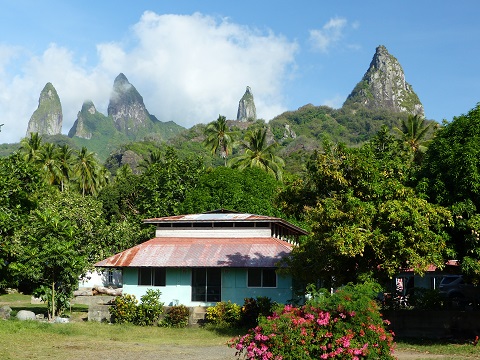 |
Random pictures from our month spent on the islands of Hiva Oa, Tahuata, Ua Pou, and Nuku Hiva
45 Photos
Created 18 July 2015
|
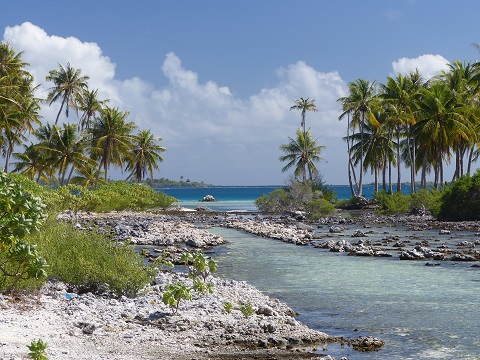 |
Random pictures from our month spent in 4 Tuamotu Atolls; Ahe, Fakarava, Tahanea, and Toau
32 Photos
Created 1 July 2015
|
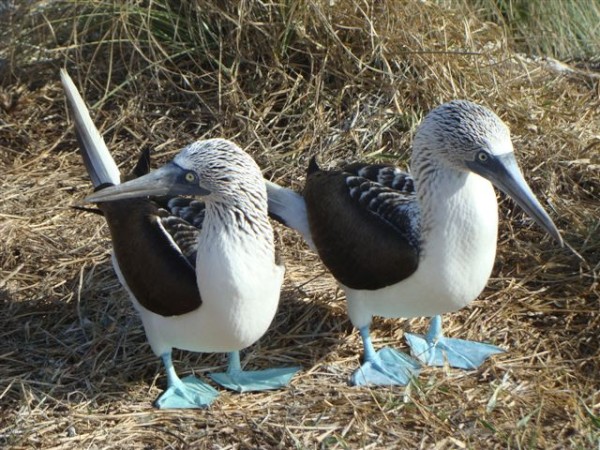 |
Some of the birds, fish, reptiles, and mammals (and others) that we have seen in Mexico
74 Photos
Created 5 May 2014
|
Tregoning

Who: Alison and Randall
Port: Gainesville, FL
